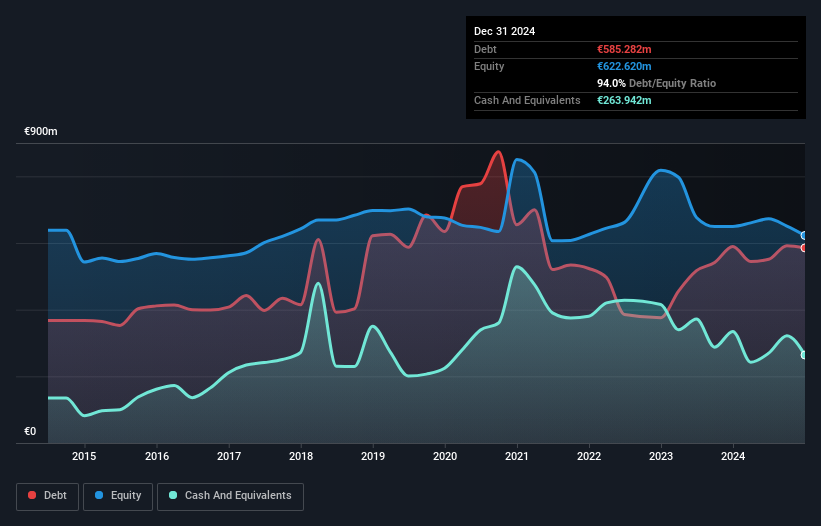
David Iben put it well when he said, 'Volatility is not a risk we care about. What we care about is avoiding the permanent loss of capital.' When we think about how risky a company is, we always like to look at its use of debt, since debt overload can lead to ruin. As with many other companies ENCE Energía y Celulosa, S.A. (BME:ENC) makes use of debt. But the more important question is: how much risk is that debt creating?
What Risk Does Debt Bring?
Debt assists a business until the business has trouble paying it off, either with new capital or with free cash flow. In the worst case scenario, a company can go bankrupt if it cannot pay its creditors. However, a more usual (but still expensive) situation is where a company must dilute shareholders at a cheap share price simply to get debt under control. Having said that, the most common situation is where a company manages its debt reasonably well - and to its own advantage. The first thing to do when considering how much debt a business uses is to look at its cash and debt together.
What Is ENCE Energía y Celulosa's Net Debt?
As you can see below, ENCE Energía y Celulosa had €585.3m of debt, at December 2024, which is about the same as the year before. You can click the chart for greater detail. However, it does have €263.9m in cash offsetting this, leading to net debt of about €321.3m.

A Look At ENCE Energía y Celulosa's Liabilities
Zooming in on the latest balance sheet data, we can see that ENCE Energía y Celulosa had liabilities of €445.2m due within 12 months and liabilities of €614.7m due beyond that. On the other hand, it had cash of €263.9m and €76.0m worth of receivables due within a year. So its liabilities outweigh the sum of its cash and (near-term) receivables by €719.9m.
Given this deficit is actually higher than the company's market capitalization of €676.6m, we think shareholders really should watch ENCE Energía y Celulosa's debt levels, like a parent watching their child ride a bike for the first time. Hypothetically, extremely heavy dilution would be required if the company were forced to pay down its liabilities by raising capital at the current share price.
Check out our latest analysis for ENCE Energía y Celulosa
In order to size up a company's debt relative to its earnings, we calculate its net debt divided by its earnings before interest, tax, depreciation, and amortization (EBITDA) and its earnings before interest and tax (EBIT) divided by its interest expense (its interest cover). Thus we consider debt relative to earnings both with and without depreciation and amortization expenses.
While ENCE Energía y Celulosa has a quite reasonable net debt to EBITDA multiple of 2.2, its interest cover seems weak, at 1.7. In large part that's it has so much depreciation and amortisation. While companies often boast that these charges are non-cash, most such businesses will therefore require ongoing investment (that is not expensed.) In any case, it's safe to say the company has meaningful debt. Notably, ENCE Energía y Celulosa made a loss at the EBIT level, last year, but improved that to positive EBIT of €51m in the last twelve months. When analysing debt levels, the balance sheet is the obvious place to start. But it is future earnings, more than anything, that will determine ENCE Energía y Celulosa's ability to maintain a healthy balance sheet going forward. So if you want to see what the professionals think, you might find this free report on analyst profit forecasts to be interesting.
But our final consideration is also important, because a company cannot pay debt with paper profits; it needs cold hard cash. So it's worth checking how much of the earnings before interest and tax (EBIT) is backed by free cash flow. In the last year, ENCE Energía y Celulosa created free cash flow amounting to 3.4% of its EBIT, an uninspiring performance. That limp level of cash conversion undermines its ability to manage and pay down debt.
Our View
Mulling over ENCE Energía y Celulosa's attempt at covering its interest expense with its EBIT, we're certainly not enthusiastic. But at least its EBIT growth rate is not so bad. We're quite clear that we consider ENCE Energía y Celulosa to be really rather risky, as a result of its balance sheet health. For this reason we're pretty cautious about the stock, and we think shareholders should keep a close eye on its liquidity. When analysing debt levels, the balance sheet is the obvious place to start. But ultimately, every company can contain risks that exist outside of the balance sheet. Be aware that ENCE Energía y Celulosa is showing 2 warning signs in our investment analysis , you should know about...
Of course, if you're the type of investor who prefers buying stocks without the burden of debt, then don't hesitate to discover our exclusive list of net cash growth stocks, today.
Valuation is complex, but we're here to simplify it.
Discover if ENCE Energía y Celulosa might be undervalued or overvalued with our detailed analysis, featuring fair value estimates, potential risks, dividends, insider trades, and its financial condition.
Access Free AnalysisHave feedback on this article? Concerned about the content? Get in touch with us directly. Alternatively, email editorial-team (at) simplywallst.com.
This article by Simply Wall St is general in nature. We provide commentary based on historical data and analyst forecasts only using an unbiased methodology and our articles are not intended to be financial advice. It does not constitute a recommendation to buy or sell any stock, and does not take account of your objectives, or your financial situation. We aim to bring you long-term focused analysis driven by fundamental data. Note that our analysis may not factor in the latest price-sensitive company announcements or qualitative material. Simply Wall St has no position in any stocks mentioned.
About BME:ENC
ENCE Energía y Celulosa
Produces and sells eucalyptus hardwood pulp and renewable energy in Spain, Germany, Poland, Italy, the Netherlands, the United Kingdom, Greece, Turkey, and internationally.
Fair value with moderate growth potential.
Similar Companies
Market Insights
Community Narratives



